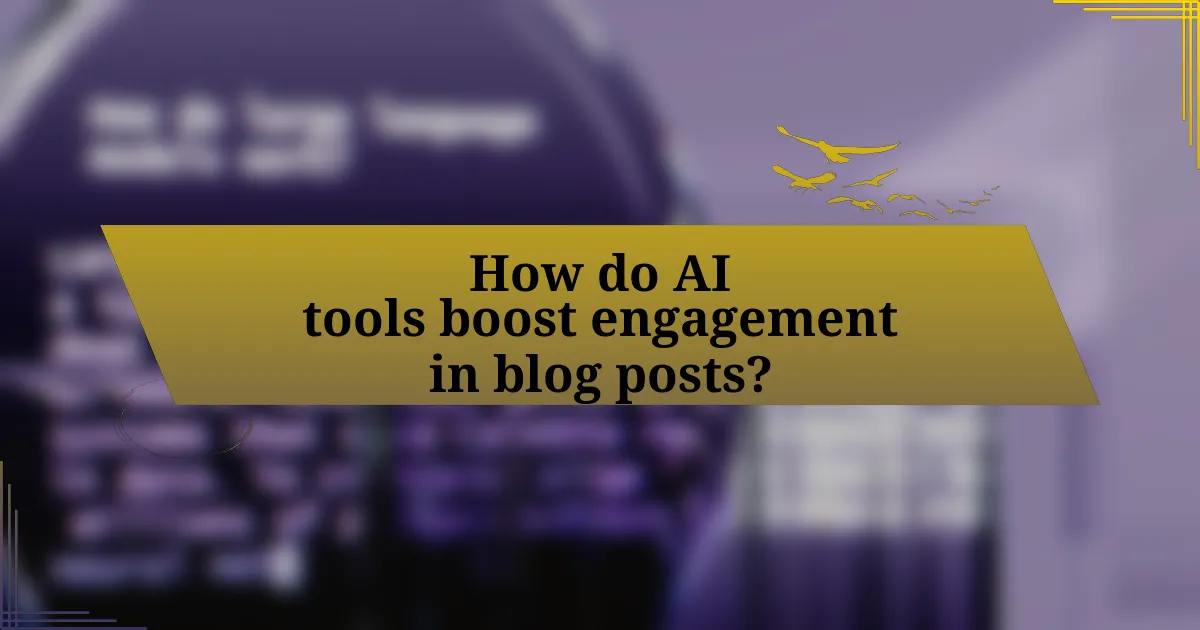The article focuses on how AI tools enhance readability and engagement in blog posts. It outlines the various features of AI, such as grammar checking, readability scoring, and content summarization, which contribute to clearer communication and improved reader retention. The role of natural language processing in optimizing text clarity is discussed, along with the importance of readability for audience engagement and retention. Additionally, the article highlights best practices for integrating AI tools into blogging, emphasizing the balance between AI assistance and maintaining a unique writing voice. Overall, it provides insights into the metrics used to measure readability and the impact of personalized content on reader interaction.

How do AI tools enhance readability in blog posts?
AI tools enhance readability in blog posts by analyzing text structure, suggesting improvements, and optimizing language for clarity. These tools utilize algorithms to assess sentence length, word choice, and overall coherence, making recommendations that align with best practices in writing. For instance, tools like Grammarly and Hemingway Editor provide real-time feedback on grammar, style, and readability scores, which are based on established readability formulas such as the Flesch-Kincaid index. This data-driven approach helps writers create content that is easier to understand, thereby increasing reader engagement and retention.
What specific features of AI tools improve text clarity?
AI tools improve text clarity through features such as grammar and style checking, readability scoring, and content summarization. Grammar and style checking ensures that sentences are free from errors and adhere to standard writing conventions, which enhances overall comprehension. Readability scoring evaluates text complexity and suggests adjustments to make content more accessible to a broader audience, often using metrics like the Flesch-Kincaid readability tests. Content summarization condenses lengthy passages into concise versions, allowing readers to grasp key points quickly. These features collectively contribute to clearer communication and better engagement in blog posts.
How does natural language processing contribute to readability?
Natural language processing (NLP) enhances readability by analyzing text structure, grammar, and vocabulary to improve clarity and comprehension. NLP algorithms can identify complex sentences, suggest simpler alternatives, and ensure consistent terminology, making content more accessible to readers. For instance, tools like Grammarly and Hemingway use NLP to provide real-time feedback on sentence length and readability scores, helping writers create clearer and more engaging blog posts. Studies have shown that texts optimized for readability can lead to higher engagement rates, as readers are more likely to understand and retain information presented in a straightforward manner.
What role does grammar checking play in enhancing blog post quality?
Grammar checking plays a crucial role in enhancing blog post quality by ensuring clarity, coherence, and professionalism in writing. When grammar is checked, errors such as incorrect punctuation, subject-verb agreement, and sentence structure are identified and corrected, which improves the overall readability of the content. Research indicates that well-edited posts are more likely to engage readers, as they convey information more effectively and maintain the audience’s attention. For instance, a study published in the Journal of Business Communication found that clear and grammatically correct writing significantly increases reader comprehension and retention of information. Thus, grammar checking directly contributes to a blog’s ability to communicate ideas effectively and maintain a professional standard.
Why is readability important for blog engagement?
Readability is crucial for blog engagement because it directly influences how easily readers can comprehend and interact with the content. When blog posts are easy to read, they retain the audience’s attention, leading to longer time spent on the page and increased likelihood of sharing the content. Research indicates that articles with higher readability scores see a 60% increase in reader retention compared to those with lower scores. This correlation highlights that clear, concise language and well-structured formatting enhance user experience, ultimately driving higher engagement metrics such as comments, shares, and return visits.
How does readability affect user retention on blogs?
Readability significantly impacts user retention on blogs by influencing how easily readers can comprehend and engage with the content. Higher readability scores, often achieved through clear language, concise sentences, and effective formatting, lead to increased user satisfaction and prolonged reading sessions. Research indicates that content with a Flesch-Kincaid readability score of 60-70 is optimal for general audiences, as it balances complexity and simplicity, making it accessible. Consequently, blogs that prioritize readability tend to see lower bounce rates and higher return visits, as users are more likely to engage with content that is easy to read and understand.
What metrics can be used to measure readability in blog posts?
Metrics that can be used to measure readability in blog posts include the Flesch-Kincaid Readability Score, Gunning Fog Index, and SMOG Index. The Flesch-Kincaid Readability Score evaluates text based on sentence length and syllable count, providing a grade level that indicates the education required to understand the content. The Gunning Fog Index assesses the complexity of the text by considering the average sentence length and the percentage of complex words, also yielding a grade level. The SMOG Index focuses on the number of polysyllabic words to determine the years of education needed for comprehension. These metrics are widely recognized in readability research and are utilized by writers and editors to enhance clarity and engagement in blog posts.

How do AI tools boost engagement in blog posts?
AI tools boost engagement in blog posts by personalizing content and optimizing readability. These tools analyze user behavior and preferences, allowing writers to tailor their posts to specific audience segments, which increases relevance and interest. For instance, AI-driven analytics can identify trending topics and suggest keywords that resonate with readers, enhancing the likelihood of shares and comments. Additionally, AI tools can improve readability by suggesting simpler language, better structure, and appropriate formatting, making content more accessible. Research indicates that posts optimized for readability can see up to a 50% increase in reader retention and interaction rates.
What techniques do AI tools use to personalize content for readers?
AI tools use techniques such as user behavior analysis, natural language processing, and machine learning algorithms to personalize content for readers. User behavior analysis involves tracking interactions, preferences, and engagement metrics to tailor content that resonates with individual users. Natural language processing enables AI to understand and generate text that aligns with the reader’s interests and reading level. Machine learning algorithms continuously learn from user feedback and interactions, refining content recommendations over time. These methods collectively enhance the relevance and appeal of content, leading to improved reader engagement and satisfaction.
How does content recommendation influence reader engagement?
Content recommendation significantly enhances reader engagement by personalizing the user experience and increasing the relevance of the content presented. When algorithms analyze user behavior and preferences, they can suggest articles or topics that align closely with individual interests, leading to longer reading sessions and higher interaction rates. Research indicates that personalized content recommendations can boost click-through rates by up to 300%, demonstrating their effectiveness in capturing reader attention and fostering deeper engagement.
What impact does audience analysis have on content creation?
Audience analysis significantly impacts content creation by ensuring that the material resonates with the target demographic. By understanding the preferences, interests, and needs of the audience, content creators can tailor their messaging, tone, and format to enhance engagement. For instance, research indicates that content aligned with audience expectations can increase reader retention by up to 60%. This alignment not only improves the effectiveness of the communication but also fosters a stronger connection between the content and its consumers, ultimately driving higher engagement rates.
Why is engagement crucial for the success of a blog?
Engagement is crucial for the success of a blog because it directly influences audience retention and interaction. High engagement levels lead to increased time spent on the blog, which signals to search engines that the content is valuable, thereby improving search rankings. According to a study by HubSpot, blogs with higher engagement rates see a 97% increase in inbound links, enhancing their visibility and authority. Additionally, engaged readers are more likely to share content on social media, further expanding the blog’s reach and attracting new visitors.
How does increased engagement lead to higher conversion rates?
Increased engagement leads to higher conversion rates by fostering a deeper connection between the audience and the content, which enhances the likelihood of desired actions, such as purchases or sign-ups. When users interact more with content—through comments, shares, or prolonged reading—they develop trust and interest in the brand or product. Research indicates that engaged users are 5 times more likely to convert compared to disengaged users, as they perceive the content as more relevant and valuable. This correlation is supported by a study from HubSpot, which found that companies with higher engagement rates experience a 20% increase in conversion rates.
What are the long-term benefits of maintaining high engagement levels?
Maintaining high engagement levels leads to improved retention rates and increased loyalty among audiences. Engaged individuals are more likely to return, share content, and participate actively, which fosters a community around the content. Research indicates that organizations with high engagement levels experience a 20% increase in productivity and a 25% increase in profitability, as noted in a Gallup study. This correlation demonstrates that sustained engagement not only enhances user experience but also drives measurable business outcomes.

What are the best practices for using AI tools in blogging?
The best practices for using AI tools in blogging include leveraging AI for content generation, optimizing SEO, and enhancing readability. Content generation tools can assist bloggers in creating high-quality drafts quickly, allowing for more time to focus on editing and refining the message. For instance, AI can analyze trending topics and suggest relevant content ideas, which can increase engagement by aligning with audience interests.
Additionally, using AI-driven SEO tools can help optimize blog posts for search engines, ensuring better visibility and reach. These tools analyze keywords, suggest improvements, and track performance metrics, which are essential for driving traffic.
Furthermore, AI can enhance readability by providing grammar and style suggestions, ensuring that the content is clear and accessible. Tools like Grammarly or Hemingway App can analyze text for complexity and readability scores, helping bloggers tailor their writing to their target audience.
In summary, effectively using AI tools in blogging involves integrating content generation, SEO optimization, and readability enhancement to create engaging and accessible blog posts.
How can bloggers effectively integrate AI tools into their writing process?
Bloggers can effectively integrate AI tools into their writing process by utilizing AI-driven content generation, grammar checking, and readability analysis tools. These tools assist in creating high-quality content quickly, ensuring grammatical accuracy, and enhancing the overall readability of blog posts. For instance, platforms like Grammarly and Hemingway Editor provide real-time feedback on writing style and clarity, which can significantly improve engagement metrics. According to a study by the Content Marketing Institute, 70% of marketers believe that using AI tools enhances their content quality, leading to increased audience engagement. By leveraging these AI capabilities, bloggers can streamline their writing process and produce more compelling content.
What are the common pitfalls to avoid when using AI tools?
Common pitfalls to avoid when using AI tools include over-reliance on automation, lack of human oversight, and ignoring context. Over-reliance on automation can lead to generic content that lacks originality and fails to engage readers effectively. Lack of human oversight may result in errors or misinterpretations that diminish the quality of the output. Ignoring context can cause AI-generated content to miss the nuances of the subject matter, leading to misunderstandings or irrelevant information. These pitfalls can significantly undermine the effectiveness of AI tools in enhancing readability and engagement in blog posts.
How can bloggers balance AI assistance with their unique voice?
Bloggers can balance AI assistance with their unique voice by using AI tools to enhance their writing while maintaining personal style. AI can analyze readability and suggest improvements, but bloggers should selectively implement these suggestions to ensure their authentic tone remains intact. For instance, a study by the Content Marketing Institute found that 70% of successful bloggers attribute their engagement to a distinct voice, emphasizing the importance of personal expression even when utilizing AI. By integrating AI-generated insights without compromising their individuality, bloggers can create content that is both engaging and true to their voice.
What tips can enhance the effectiveness of AI tools in blog posts?
To enhance the effectiveness of AI tools in blog posts, utilize clear prompts and specific guidelines for content generation. Clear prompts help AI understand the desired tone, style, and subject matter, leading to more relevant and engaging content. For instance, specifying the target audience and key points can significantly improve the output quality. Additionally, incorporating AI-generated suggestions for headlines, keywords, and structure can optimize SEO and readability. Research indicates that posts with optimized headlines can increase click-through rates by up to 36%, demonstrating the impact of effective AI utilization.
How can continuous learning improve the use of AI tools in blogging?
Continuous learning enhances the use of AI tools in blogging by enabling bloggers to stay updated with the latest advancements and best practices in AI technology. This ongoing education allows bloggers to effectively leverage AI tools for content creation, optimization, and audience engagement, ultimately improving the quality and relevance of their blog posts. For instance, a study by McKinsey & Company found that organizations that prioritize continuous learning are 46% more likely to be first to market with new products, indicating that staying informed about AI developments can lead to more innovative and engaging content strategies in blogging.
What resources are available for bloggers to learn about AI tools?
Bloggers can access various resources to learn about AI tools, including online courses, webinars, and dedicated websites. Platforms like Coursera and Udemy offer courses specifically focused on AI applications in content creation, while websites such as HubSpot and Content Marketing Institute provide articles and guides on integrating AI tools into blogging practices. Additionally, communities on social media platforms like LinkedIn and Facebook host discussions and share insights about the latest AI tools, enhancing bloggers’ understanding and application of these technologies.

